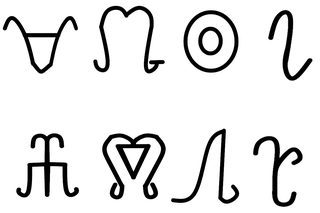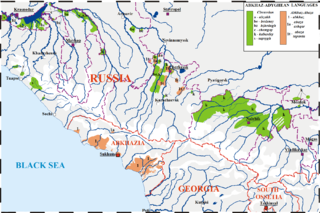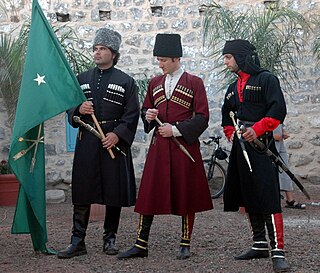
Circassia, also known as Zichia, was a country and a historical region in Eastern Europe. It spanned the western coastal portions of the North Caucasus, along the northeastern shore of the Black Sea. Circassia was conquered by the Russian Empire during the Russo-Circassian War (1763–1864), after which approximately 99.5-99.8% of the Circassian people were either exiled or massacred in the Circassian genocide.

The Circassians or Circassian people, also called Cherkess or Adyghe are a Northwest Caucasian ethnic group and nation who originated in Circassia, a region and former country in the North Caucasus.

Kuban is a historical and geographical region in the North Caucasus region of southern Russia surrounding the Kuban River, on the Black Sea between the Don Steppe, the Volga Delta and separated from the Crimean Peninsula to the west by the Kerch Strait. Krasnodar Krai is often referred to as Kuban, both officially and unofficially, although the term is not exclusive to the krai and also accommodates the republics of Adygea, Karachay-Cherkessia, and parts of Stavropol Krai.

The Hatuqway are one of the twelve major Circassian tribes, representing one of the twelve stars on the green-and-gold Circassian flag. They were known for their art of war as a warrior tribe. After the Russo-Circassian War, their presence in the Caucasus was destroyed during the Circassian genocide, and their number was significantly decreased and today they exist only in small communities in various diasporas, and their names are not mentioned anymore in Circassian dialectology.

The Shapsug are one of the twelve major Circassian tribes. Historically, the Shapsug tribe comprised one of the largest groups of the Black Sea Adyghe. They inhabited the region between the Dzhubga River and the Shakhe Rivers and high-altitude mountainous areas of the northern slopes of the Caucasus range along the Antkhir, Abin, Afips, Bakan, Ships, and other rivers . In Russia, the remaining Shapsug population mainly live in the Tuapsinsky District (Tuapse) of Krasnodar Krai, Lazarevsky City District of Sochi, and in the Republic of Adygea, which were a small part of historical Circassia.

The Circassian genocide, or Tsitsekun, was the systematic mass killing, ethnic cleansing, and expulsion of between 95% and 97% of the Circassian people during the final stages of the Russian invasion of Circassia in the 19th century. It resulted in the deaths of between 625,000 and 1.5 million and the destruction of Circassia, which was then annexed by the Russian Empire. Those planned for extermination were mainly the Circassians, who are predominantly Muslims, but other Muslim Caucasian peoples were also affected, as part of the Caucasian War. Notable killing methods used by the Imperial Russian Army in Circassia included impalement and tearing open the bellies of pregnant women in order to intimidate the Circassians and devastate their morale. Many Russian generals, such as Grigory Zass, described the Circassians as "subhuman filth" and a "lowly race" to justify and glorify their wholesale slaughter and their use as human test subjects in unethical scientific experiments. Russian soldiers were also permitted to rape Circassian women.
The Abzakh are one of the twelve major Circassian tribes, representing one of the twelve stars on the green-and-gold Circassian flag. Historically, they lived in the mountainous part of the modern Russian republics of Adygea and Krasnodar Krai. Major settlements or villages were located in the river valleys Kurdzhips, Psheha, Pshish, and Psekups.

The Circassian flag is the national flag of the Circassians. It consists of a green field charged with twelve gold stars, nine forming an arc resembling a bow and three horizontal, also charged with three crossed arrows in the center. Seferbiy Zaneqo, a Circassian diplomat, is the designer of the flag. Every year, April 25 is celebrated as the Circassian flag day by Circassians. Another version of the flag is currently officially used by the Republic of Adygea of the Russian Federation as its national flag.

The Circassians in Kosovo were a group of the Circassian people who lived in Kosovo beginning in the mid-19th century, when they were exiled during the Circassian genocide to the Ottoman Empire after the Russo-Circassian War. During this time, the Circassians in Kosovo were from three of the twelve Adyghe tribes: the Abzakh, Shapsug and Ubykh. In 1998 they numbered 200.

Circassian nationalism is the desire among Circassians worldwide to preserve their genes, heritage and culture, save their language from extinction, raise awareness about the Circassian genocide, return to Circassia and establish a completely autonomous or independent Circassian state in its pre-Russian invasion borders.

Circassians in Israel are Israelis who are ethnic Circassians. They are a branch of the Circassian diaspora, which was formed as a consequence of the 19th-century Circassian genocide that was carried out by the Russian Empire during the Russo-Circassian War; Circassians are a Northwest Caucasian ethnic group and a nation; who natively speak the Circassian languages and originate from the historical country-region of Circassia in the North Caucasus. Most Circassians in Israel are Muslims.

The Natukhaj are one of the twelve major Circassian tribes, representing one of the twelve stars on the green-and-gold Circassian flag. Their areas historically extended along the Black Sea coast from Anapa in the north to Tsemes Bay in the south and from the north side of the mountains to the lower Kuban River.
The Shapsug National District or Shapsug National Raion was a district that was established in 1924 as a national district (raion) for the Circassian Shapsugs tribe of the Black Sea Circassians within the Krasnodar Krai in the Soviet Union, now Russia. It was abolished after the end of the Second World War in 1945.

The Circassian Parliament or the Circassian Majlis was the legislature of Circassia officialized in 1861 after a meeting in Sochi attended by leaders of several Circassian provinces. A tribal confederation had existed before the parliament's establishment, but a centralized government was achieved only after it was built.
The Zhaney, or Jane, were one of the twelve major Circassian tribes, representing one of the twelve stars on the green-and-gold Circassian flag. Modern descendants live in Adygea.

The Circassians in Bulgaria were a large ethnic minority in the territory that constitutes modern Bulgaria. In the late 19th century, they numbered around 150,000. In 1992, 573 people in the country identified themselves as Circassian.
The Khegayk or Shegayk were one of the Circassian tribes. They were completely exterminated in the Circassian genocide following the Russo-Circassian War. None were recorded to have survived. In some sources, they are also mentioned under the name "Shegayk".
The Chebsin or Tsopsin were a Circassian tribe. They were destroyed in the Circassian genocide following the Russo-Circassian War.
The Makhosh were one of the Circassian tribes. The tribe was mostly annihilated in the Circassian genocide following the Russo-Circassian War. A single family remains and lives mostly in the Circassian diaspora.











